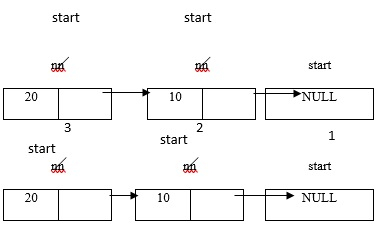
 Data Structure
Data Structure Networking
Networking RDBMS
RDBMS Operating System
Operating System Java
Java MS Excel
MS Excel iOS
iOS HTML
HTML CSS
CSS Android
Android Python
Python C Programming
C Programming C++
C++ C#
C# MongoDB
MongoDB MySQL
MySQL Javascript
Javascript PHP
PHP
- Selected Reading
- UPSC IAS Exams Notes
- Developer's Best Practices
- Questions and Answers
- Effective Resume Writing
- HR Interview Questions
- Computer Glossary
- Who is Who
Explain the stack by using linked list in C language
Stack over flow and stack under flow can be avoided by allocating memory dynamically.
Operations carried out under stack in C programming language are as follows −
- Push
- Pop
Push
Following is the basic implementation of a linked list −
&item = 10 newnode = (node*) malloc (sizeof (node)); newnode ->data = item; newnode ->link = NULL; newnode ->link = start; start = newnode;

pop
The syntax is as follows −
Syntax
if (start = = NULL)
printf("Deletion is not possible.List is empty")
else{
temp = start;
start = start link;
free (temp);
}
Program
Following is the C program for stack by using linked lists −
#include <stdio.h>
#include <stdlib.h>
struct node{
int info;
struct node *ptr;
}*top,*top1,*temp;
int topelement();
void push(int data);
void pop();
void empty();
void display();
void destroy();
void stack_count();
void create();
int count = 0;
void main(){
int no, ch, e;
printf("
1 - Push");
printf("
2 - Pop");
printf("
3 - Top");
printf("
4 - Empty");
printf("
5 - Exit");
printf("
6 - Display");
printf("
7 - Stack Count");
printf("
8 - Destroy stack");
create();
while (1){
printf("
Enter choice : ");
scanf("%d", &ch);
switch (ch){
case 1:
printf("Enter element : ");
scanf("%d", &no);
push(no);
break;
case 2:
pop();
break;
case 3:
if (top == NULL)
printf("stack is empty");
else{
e = topelement();
printf("
Top element : %d", e);
}
break;
case 4:
empty();
break;
case 5:
exit(0);
case 6:
display();
break;
case 7:
stack_count();
break;
case 8:
destroy();
break;
default :
printf(" wrong choice:Try again ");
break;
}
}
}
//empty stack
void create(){
top = NULL;
}
void stack_count(){
printf("
no: of elements in stack : %d", count);
}
//push data
void push(int data){
if (top == NULL){
top =(struct node *)malloc(1*sizeof(struct node));
top->ptr = NULL;
top->info = data;
}
else{
temp =(struct node *)malloc(1*sizeof(struct node));
temp->ptr = top;
temp->info = data;
top = temp;
}
count++;
}
void display(){
top1 = top;
if (top1 == NULL){
printf("empty stack");
return;
}
while (top1 != NULL){
printf("%d ", top1->info);
top1 = top1->ptr;
}
}
void pop(){
top1 = top;
if (top1 == NULL){
printf("
error");
return;
}
else
top1 = top1->ptr;
printf("
Popped value : %d", top->info);
free(top);
top = top1;
count--;
}
int topelement(){
return(top->info);
}
//check stack empty or not
void empty(){
if (top == NULL)
printf("
empty stack");
else
printf("
stack not empty with %d values", count);
}
void destroy(){
top1 = top;
while (top1 != NULL){
top1 = top->ptr;
free(top);
top = top1;
top1 = top1->ptr;
}
free(top1);
top = NULL;
printf("
all are destroyed");
count = 0;
}
Output
When the above program is executed, it produces the following result −
1 - Push 2 - Pop 3 - Top 4 - Empty 5 - Exit 6 - Display 7 - Stack Count 8 - Destroy stack Enter choice: 1 Enter element: 23 Enter choice: 1 Enter element: 45 Enter choice: 1 Enter element: 56 Enter choice: 2 Popped value: 56 Enter choice: 6 45 23 Enter choice: 8 all are destroyed Enter choice: 6 empty stack Enter choice: 5

Advertisements
